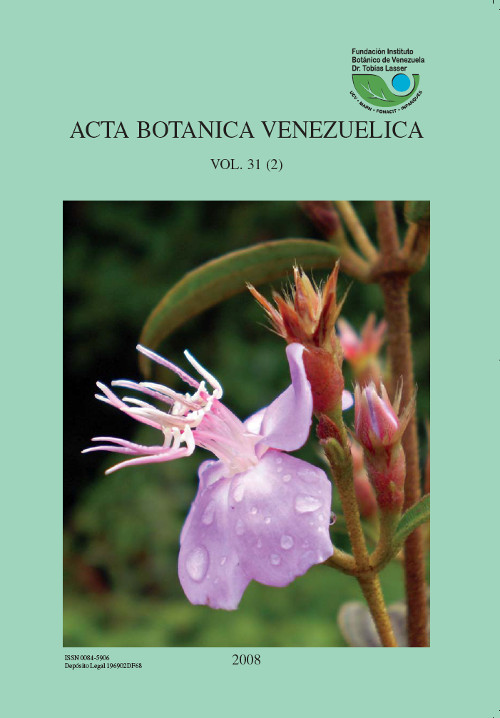SISTEMAS REPRODUCTIVOS EN ESPECIES DE MELASTOMATACEAE EN LAGRAN SABANA(ESTADO BOLÍVAR, VENEZUELA)
Resumen
RESUMEN
La biología reproductiva de 17 especies de Melastomataceae fue estudiada en la GranSabana (estado Bolívar,Venezuela) mediante cruces controlados en el campo; se determinóel índice polen/óvulo, la asignación de biomasa floral y la eficiencia reproductiva natural paracada especie y su relación con el sistema reproductivo. La agamospermia (tres especies(17,7%) agamospermas y seis (35,3%) facultativas) fue el sistema reproductivo predominante,seguida por la autocompatibilidad (siete especies, 41,2%) y sólo Tococa guianensis es autoincompatible.La mayoría de las especies estudiadas presentaron alta relación polen/óvulo,lo cual no se corresponde con sistemas agamospermos de reproducción. La biomasa floral revelóque la especie autoincompatible tiene la mayor relación de biomasa androceo/biomasade gineceo, lo que concuerda con la hipótesis de asignación de biomasa. Sin embargo, los patronesde asignación de biomasa en los otros sistemas reproductivos no mostraron tendenciasclaras. La producción de frutos fue altamente variable e independiente del sistema reproductivo;no obstante, todas las especies autocompatibles mostraron bajos niveles de producciónde frutos y la especie autoincompatible tuvo alto valor de producción de frutos por flor.
ABSTRACT
The reproductive biology of 17 species of Melastomataceae was studied in the GranSabana plateau (Bolívar State,Venezuela) by means controlled crossings in the field; thepollen/ovule ratio, the allocation of floral biomass and the natural reproductive efficiency foreach species and its relation with the breeding system were estimated. Agamospermy (threespecies (17.7%) and six (35.3%) facultatives) was the reproductive system, followed by self compatibility (seven species, 41.2%), and only Tococa guianensis was selfincompatible.Most of the studied species displayed high pollen/ovule ratio, which does not correspondwith agamospermous reproductive systems. Floral biomass revealed that the selfincompatiblespecies has the greater androecium/gynoecium biomass ratio, which agrees with the hypothesisof biomass allocation. Nevertheless the patterns of biomass allocation in the otherreproductive systems did not show clear tendencies. Fruit production was highly variable andindependent of the reproductive system; however, all selfcompatible species showed low levelsof fruit production and the selfincompatible species display high fruit production.
Descargas
Descargas
Número
Sección
Licencia
© Instituto Experimental Jardín Botánico "Dr. Tobías Lasser" |


